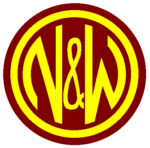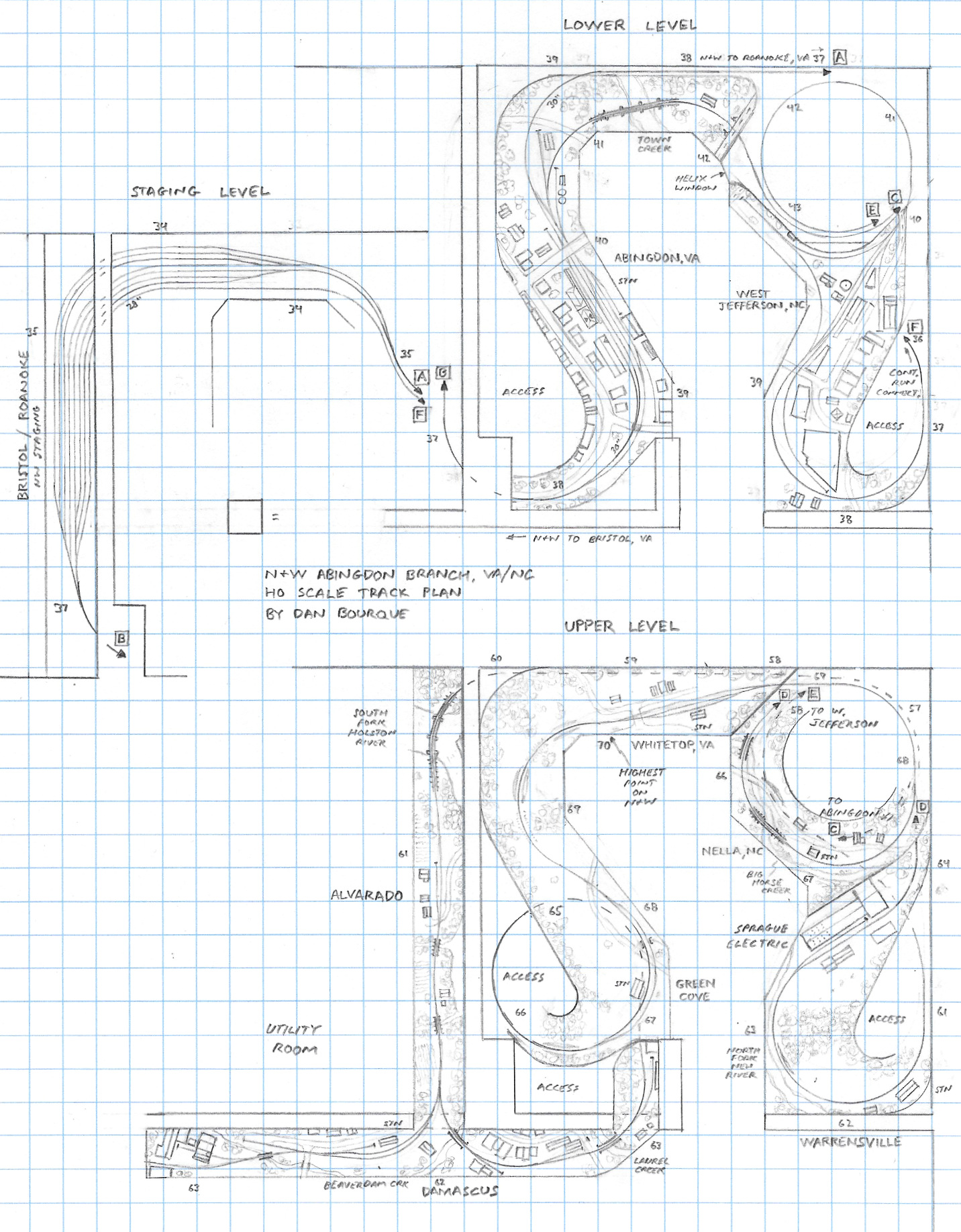- Size: 15′ x 24 ′
- Scale: HO
- Minimum Radius: 27″
- Minimum Aisle Width: 30″
- Designed by Dan Bourque
 The Norfolk and Western’s Abingdon Branch was a sleepy operation that connected small towns in the mountains of North Carolina with the N&W main at Abingdon, Virginia. The line was known for its steep grades (3%), sharp curves, numerous bridges and mixed trains (freight and passenger). This line was home to the famed “Virginia Creeper” mixed train–today, much of the line is preserved as the Virginia Creeper Trail. The highest point on the N&W was on this branch as well, the top of the grade at Whitetop, VA at 3,576 feet (incidentally the highest point east of the Rockies on any railroad to see regular passenger service as well). The line has a charm that makes it a great subject for a model railroad.
The Norfolk and Western’s Abingdon Branch was a sleepy operation that connected small towns in the mountains of North Carolina with the N&W main at Abingdon, Virginia. The line was known for its steep grades (3%), sharp curves, numerous bridges and mixed trains (freight and passenger). This line was home to the famed “Virginia Creeper” mixed train–today, much of the line is preserved as the Virginia Creeper Trail. The highest point on the N&W was on this branch as well, the top of the grade at Whitetop, VA at 3,576 feet (incidentally the highest point east of the Rockies on any railroad to see regular passenger service as well). The line has a charm that makes it a great subject for a model railroad.
The Layout
The challenge of modeling the Abingdon Branch is it was very long (56 miles from Abingdon, VA to West Jefferson, NC) with points of operational interest spread throughout the line. This track plan attempts to capture the key points of the line in a very compressed fashion to capture the feel of the line and its operations in a moderate space. It models the line as it appeared in the latter days of steam when it had been cut back from Elkland, NC to West Jefferson, but it still allows for the possibility of Elkland staging, and the tracks didn’t change much from steam days to its abandonment in 1977. The two “must have” areas for this line were the ends, Abingdon, VA and West Jefferson, NC. To represent the middle of the branch, I chose Damascus, VA and its bit of industry, Warrensville, NC and its bit of industry, the peak at Whitetop, VA, and two additional stations along the way at Green Cove and Nella (just a shed along the branch’s main).
This space is interesting because it includes a bedroom, one wall of an adjacent utility room, and a shelf in an adjacent family room. The limited space demanded a double-deck design. I let the branch’s saw-tooth profile drive which scenes went where, so the ends of the line at Abingdon and West Jefferson were assigned to the lower level. This also allowed me to turn the entire layout into a continuous running loop. Abingdon is represented in a compressed manner, but it includes the key elements of the classic station and freight house along with a few industries. The N&W main through Abingdon is connected on both ends to a double-ended staging yard making it a continuous running loop as well–I was able to preserve a 30″ minimum radius for the main. From Abingdon, the branch crosses Town Creek on the first of many bridges before entering the outer ring of a 2-track helix where it turns 3.5 times and heads along the back wall toward a utility room.
The first scene on the upper level is the crossing of the South Fork Holston River on a curved girder and trestle bridge and the small hamlet of Alvarado, VA. These scenes were included as a “bonus” to provide extra modeling possibilities, but being in the utility room, I didn’t include anything essential to operations. I took advantage of the family room shelf area for the town of Damascus, home to the short Beaver Dam Branch (formerly part of a narrow gauge line) and a few small industries. There was a lot of railroad tucked into the hills between Damascus and Green Cove, so rather than connect the scenes directly, I used a single loop to build in separation and create more running room–this also helps emphasize the steep climb of the line. From Green Cove, the line winds through a series of cuts and fills (no creeks at the top of the ridge) to Whitetop which is placed at a whopping 70″ above the floor (highest point on N&W. . . check). Rather than proceed directly to Nella, NC, I again used a loop to build in running space and separate the scenes.
From Nella, the line again goes behind the scenery and pops into the vignette of Warrensville, NC which includes the large Sprague Electric building, one of the line’s best customers. After ducking back behind the scenes again, the line descends 4 turns down the inside of the helix to pop out at West Jefferson, NC. This unfortunately cuts out the town of Smethport and its furniture plant (also a major customer), but compromises had to be made. At West Jefferson, I was able to get in all the major features including wye and water tower, the station, and the industries. To hide the awkward transition through the backdrop, I turned a grade crossing into an overpass. From West Jefferson, the line tucks around the corner and heads into staging–unnecessary for operations, but great for when you just want to run trains in circles.
Construction of this layout would be fairly complex with a double helix, lots of loops, holes through stud walls, and lots of levels (not for the faint of heart). Despite the complexity, I’ve tried to minimize the hidden runs (note the “helix window” on the lower level) and create access points to most of it. This line was served by one train at a time, so control would be simple, but based on making the N&W main active, a DCC system with walk-around throttles would be very helpful.
Operations
This layout is designed for 1-2 people, but a full operating session would take a few hours. In a 1950’s session, the Virginia Creeper (Abingdon Branch local) would start in Abingdon with it’s power, most commonly 4-8-0 No 382 or 429. No cab would be needed as the conductor sat in the passenger coach. After collecting its consist of freight cars, about 1/2 a dozen boxcars, flats, gons tank cars and perhaps a hopper of coal (to fuel the school furnaces near W. Jefferson), the train would grab its passenger cars (a baggage car and a coach) from the Abingdon station and head up the branch. The Virginia Creeper stopped at all stations along the way which on the layout includes Damascus, Green Cove, Whitetop, Nella, Warrensville, and W. Jefferson, working industries along the way as needed. The grades, tight curves and light rails made this slow work (a 25 mph speed limit was in effect in later years). For realism, not every industry should be worked every session. After arriving in West Jefferson and dropping the passenger cars at the station, the locomotive would work the local industries, turn on the wye, and get a drink before collecting its cars and heading back to Abingdon, stopping at the stations and working industries as needed. Due to the number of stub sidings, the direction of the switch probably determined whether or not the industries were worked on the way up or back to make most of the moves trailing switch moves. For towns with sidings, the sidings would probably be used more often to set cars out for the return trip than to perform run-arounds.
A second job could be running the N&W main including running a few through freights (the line to Bristol was moderately busy with Southern interchange traffic), running a passenger train each way making stops at Abingdon Station, and running a local to work the industries at Abingdon and the interchange with the branch.
Variety can be had by changing the era. In the early ’60s, the Virginia Creeper was still a mixed train until passenger service was discontinued around 1964. Power was usually a pair of GP9s. In its last decade, the local was a once-a-week affair on Thursdays (I wouldn’t recommend an ops session representing Friday-Wednesday. . . pretty boring), and the train kept getting even shorter. Also, due to the low weight restrictions on the branch’s several dozen bridges, heavier locomotives weren’t used, and many freight cars were less than full.
Things I Like About this Plan:
- Continuous running loop on both the N&W main and the branch
- Lots of great little scenes and vignette feel with many parts of the layout
- Captures the feel and key spots of the famous branch
- Generous operating aisle in the main area
Things I Don’t Like About this Plan:
- Very complex trackwork
- Some scenes in hard-to-reach areas (utility room)
- Short staging tracks
- Staging yard on a steep grade
- Very compressed
Related Products:




